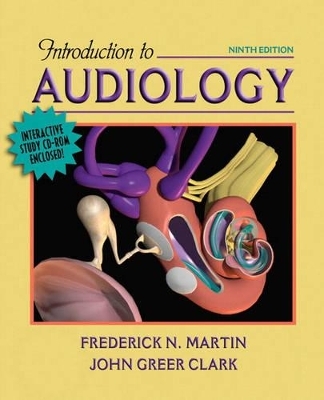
Introduction to Audiology (with CD-ROM)
Pearson
978-0-205-45330-6 (ISBN)
- Titel erscheint in neuer Auflage
- Artikel merken
Introduction to Audiology, Ninth Edition, provides in-depth coverage of the physics of sound, anatomy, and physiology of the auditory system; causes and treatment of hearing disorders; and relevant diagnostic and therapeutic techniques. It emphasizes the proper evaluation of hearing disorders and the treatment avenues available for these disorders. The accompanying CD-ROM features a wide variety of interactive exercises, actual case studies, eighteen videos illustrating many theoretical and research concepts, demonstrations, an extensive literature section with useful forms, ear pathology slides, and much more.
Each chapter begins with “Learning Objectives” and concludes with “Summary,” “Study Questions,” “References,” and “Suggested Readings.”
Foreword.
Preface.
How to Use This Book.
How to Use the CD-ROM.
About the Authors.
I. ELEMENTS OF AUDIOLOGY.
1. The Profession of Audiology.
The Evolution of Audiology
Licensing and Certification
Prevalence and Impact of Hearing Loss
A Blending of Art and Science
Audiology Specialties
Employment SettingsProfessional Societies
2. The Human Ear and Simple Tests of Hearing.
Anatomy and Physiology of the Ear
Pathways of Sound
Types of Hearing Loss
Hearing Tests
Tuning Fork Tests
3. Sound and Its Measurement.
Sound
Waves
Vibrations
Frequency
Resonance
Sound Velocity
Wavelength
Phase
Complex Sounds
Intensity
The Decibel
Environmental Sounds
Psychoacoustics
Impedance
Sound Measurement
II. HEARING ASSESSMENT.
4. Pure-Tone Audiometry.
The Pure-Tone Audiometer
Test Environment
The Patient’s Role in Manual Pure-Tone Audiometry
The Clinician’s Role in Manual Pure-Tone Audiometry
Air-Conduction Audiometry
Bone-Conduction Audiometry
Audiogram Interpretation
Masking
The Audiometric Weber Test
Automatic Audiometry
Computerized Audiometry
5. Speech Audiometry.
The Diagnostic Audiometer
Test Environment
The Patient’s Role in Speech Audiometry
The Clinician’s Role in Speech Audiometry
Speech-Threshold Testing
Masking for SRT
Bone-Conduction SRT
Most Comfortable Loudness Level
Uncomfortable Loudness Level
Range of Comfortable Loudness
Speech-Recognition Testing
Computerized Speech Audiometry
6. Diagnostic Hearing Tests.
Acoustic Immittance
Acoustic Reflexes
Otoacoustic Emissions (OAE)
Auditory Evoked Potentials
An Historical Note
7. Hearing Tests for Children.
Auditory Responses
Identifying Hearing Loss in Infants under 3 Months of Age
Objective Testing in Routine Pediatric Hearing Evaluation
Behavioral Testing of Children from Birth to Approximately 2 years of Age
Behavioral Testing of Children Approximately 2 to 5 Years of Age
Language Disorders
Auditory Processing Disorders
Psychological Disorders
Developmental Disabilities
Identifying Hearing Loss in the Schools
Nonorganic Hearing Loss in Children
III. HEARING DISORDERS.
8. The Outer Ear.
Anatomy and Physiology of the Outer Ear
Development of the Outer Ear
Hearing Loss and the Outer Ear
Disorders of the Outer Ear and Their Treatments
9. The Middle Ear.
Anatomy and Physiology of the Middle Ear
Development of the Middle Ear
Hearing Loss and the Middle Ear
Disorders of the Middle Ear and Their Treatments
Other Causes of Middle Ear Hearing Loss
10. The Inner Ear.
Anatomy and Physiology of the Inner Ear
Development of the Inner Ear
Hearing Loss and Disorders of the Inner Ear
Causes of Inner-Ear Disorders
11. The Auditory Nerve and Central Auditory Pathways.
Anatomy and Physiology of the Auditory Nerve and Ascending Auditory Pathways
The Descending Auditory Pathways
Development of the Auditory Nerve and Central Auditory Nervous System
Summary of the Auditory Pathways
Hearing Loss and the Auditory Nerve and Central Auditory Pathways
Disorders of the Auditory Nerve
Disorders of the Cochlear Nuclei
Disorders of the Higher Auditory Pathways
Tests of the Higher Auditory Pathways
Tests for Auditory Processing Disorders
12. Nonorganic Hearing Loss.
Terminology
Patients with Nonorganic Hearing Loss
Indications of Nonorganic Hearing Loss
Performance on Routine Hearing Tests
Tests for Nonorganic Hearing Loss
Management of Patients with Nonorganic Hearing Loss
IV. MANAGEMENT OF HEARING LOSS.
13. Amplification/Sensory Systems.
Hearing Aid Development
Hearing Aid Circuit Overview
Characteristics of Hearing Aids
Binaural Amplification
Types of Hearing Aids
Selecting Hearing Aids for Adults
Selecting Hearing Aids for Children
Hearing Aid Acceptance and Orientation
Dispensing Hearing Aids
Hearing Assistance Technologies
14. Audiologic Treatment.
Patient Histories
Referral to Other Specialists
Audiologic Counseling
Management of Adult Hearing Impairment
Management of Childhood Hearing Impairment
The Deaf Community
Management of Auditory Processing Disorders
Management of Tinnitus
Hyperacusis
Vestibular Rehabilitation
Multicultural Considerations
Evidence-Based Practice
Outcome Measures
Glossary.
Author Index.
Subject Index.
| Erscheint lt. Verlag | 5.7.2005 |
|---|---|
| Sprache | englisch |
| Maße | 188 x 232 mm |
| Gewicht | 850 g |
| Themenwelt | Medizin / Pharmazie ► Medizinische Fachgebiete ► HNO-Heilkunde |
| ISBN-10 | 0-205-45330-9 / 0205453309 |
| ISBN-13 | 978-0-205-45330-6 / 9780205453306 |
| Zustand | Neuware |
| Haben Sie eine Frage zum Produkt? |
